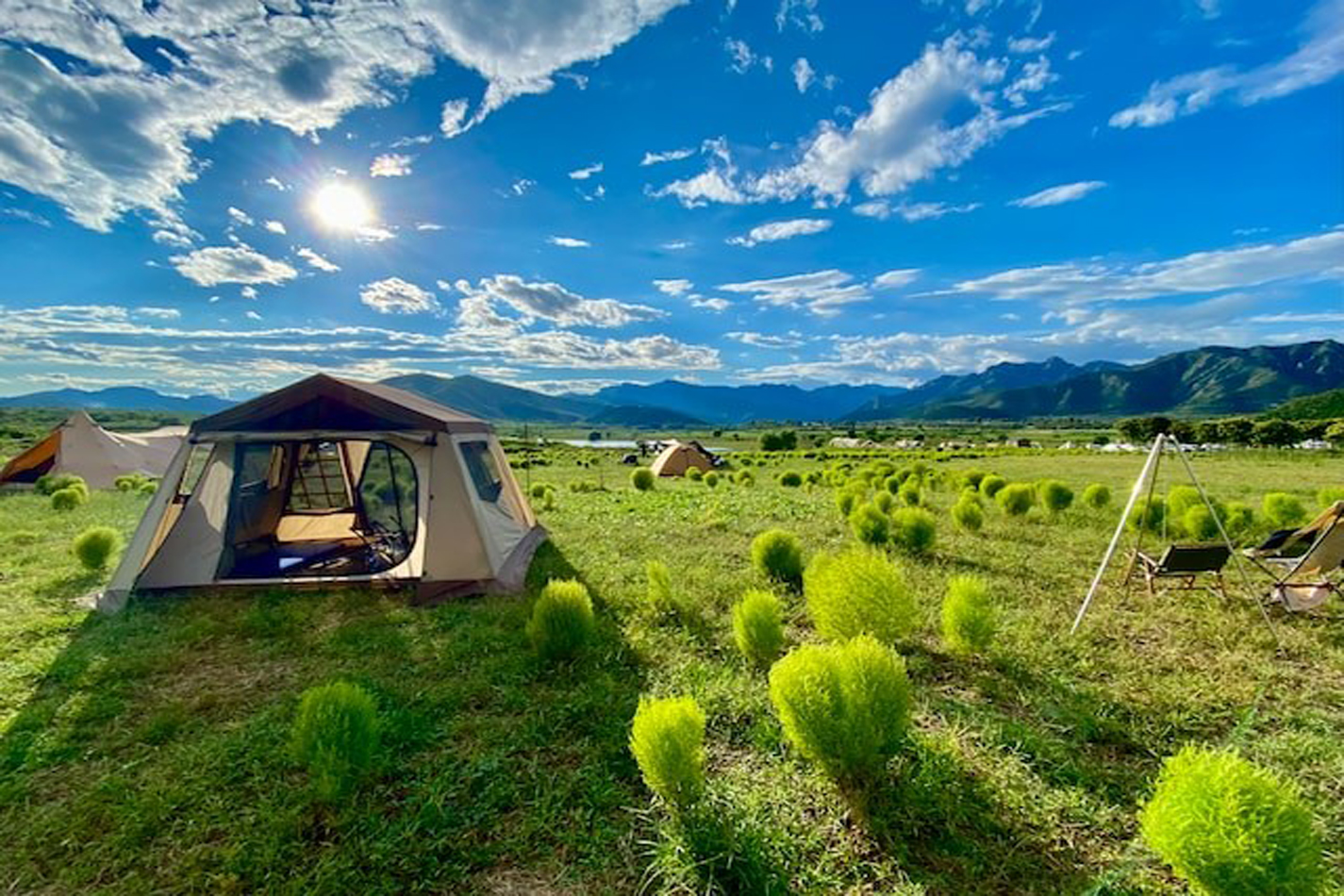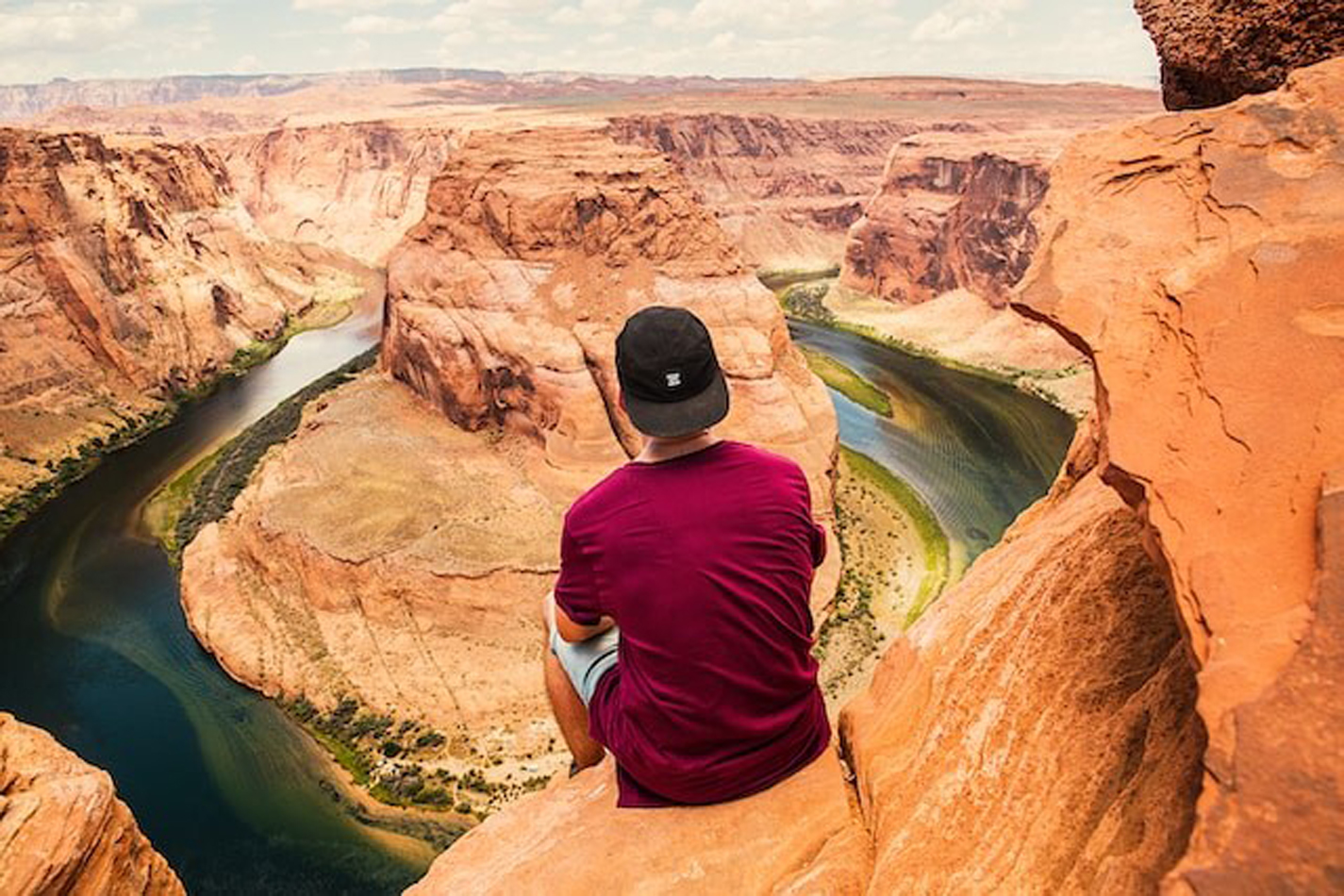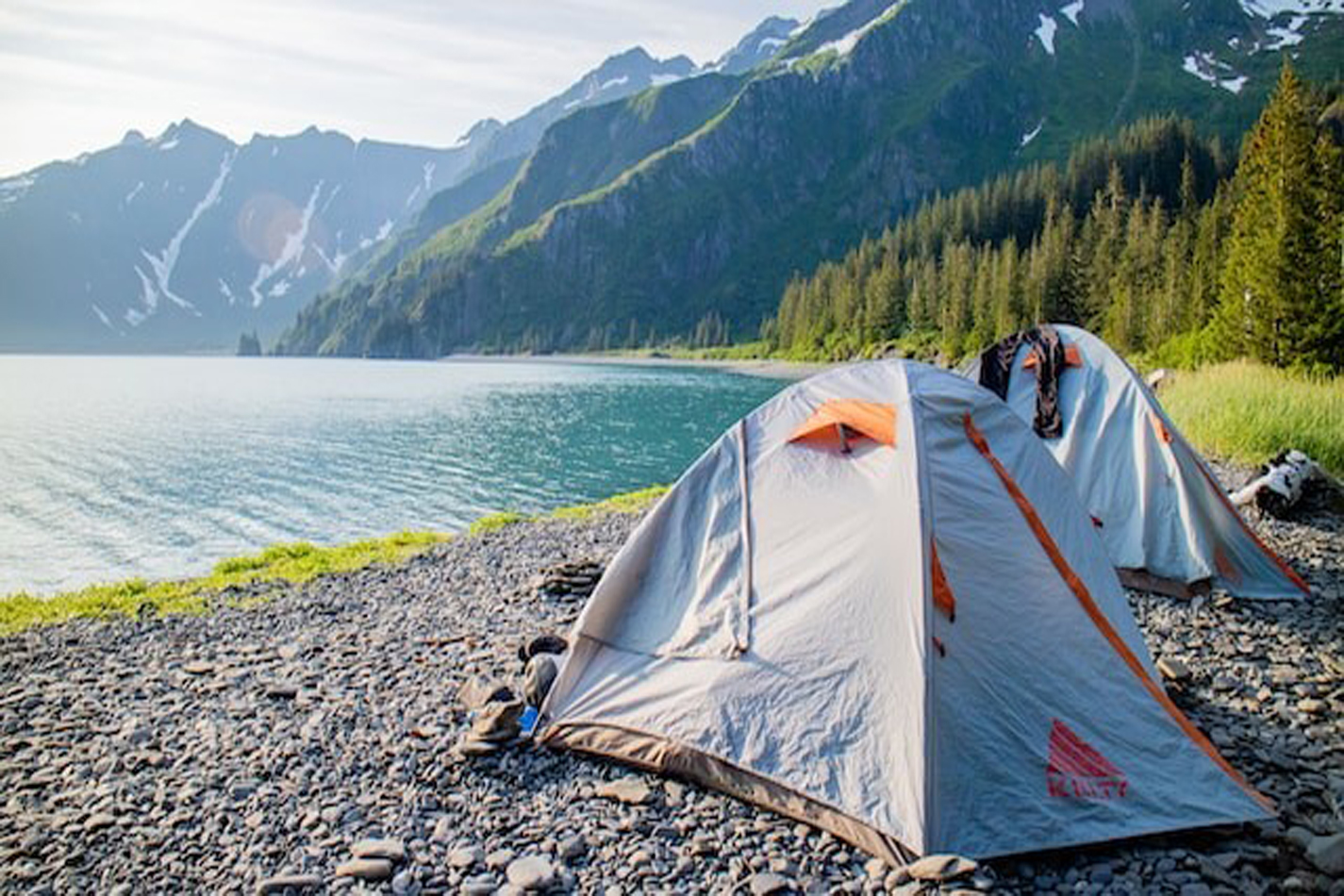When it comes to enjoying the great outdoors, few activities are as serene and exhilarating as canoeing. Whether you're navigating calm lakes or tackling mild rapids, dressing appropriately for your canoeing adventure is essential for comfort, safety, and enjoyment. In this article, we will provide you with a detailed information on what to wear when canoeing, ensuring you are well-prepared for your next paddling expedition.
If you're new to canoeing, chances are you'll be venturing out during the summer months.
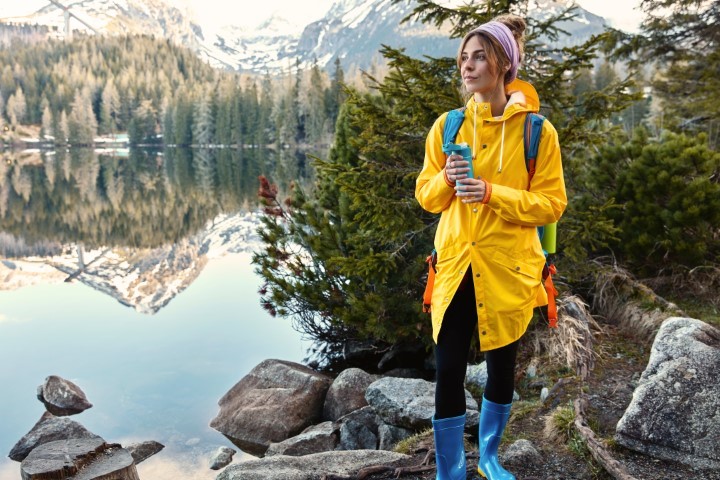
Or you might have made some mistakes in your previous trip and deliberating how you can do a better preparation for your next canoeing adventure.
Balancing your packing is essential; you don't want to over pack, but it's equally important to don flexible clothing and accessories to maintain comfort and fully enjoy your canoeing experience. Therefore, one of the most crucial steps you can take to ensure the best possible canoeing experience is to choose the appropriate clothing for your adventure.
Mastering the Art of Canoeing Dressing: The Power of Layering – A quick overview
Layering is a crucial aspect of dressing appropriately for a canoe trip. It allows you to adapt to changing weather conditions and stay comfortable throughout your adventure.
Here's a detailed guide on how to effectively layer for a canoe trip:
Base Layer:
Start with a moisture-wicking base layer. This layer is in direct contact with your skin and is designed to wick away sweat, keeping you dry. Look for materials like merino wool or synthetic fabrics.
Insulating Layer:
On cooler days, add an insulating layer. A lightweight fleece or down jacket can provide warmth without adding excessive bulk. This layer traps heat close to your body.
Weather-Resistant Layer:
Depending on the weather forecast, choose an outer layer that is weather-resistant. A waterproof and breathable jacket is ideal for protection against rain and wind. Ensure it has a hood to shield your head.
Convertible Pants:
Consider wearing convertible pants that can be converted into shorts when it gets warmer or if you plan to take a dip. These versatile pants are excellent for adapting to changing temperatures.
Gloves:
Pack a pair of gloves, preferably waterproof or water-resistant ones. They can protect your hands from the chill and offer a better grip on your paddle. It will also be useful when setting up a camp.
Headwear:
Don't forget headwear. In colder weather, opt for a beanie or a thermal hat to retain heat. In the sun, a wide-brimmed hat or a baseball cap with UV protection can shield your face.
Footwear:
Choose appropriate footwear based on the conditions. Water shoes or sandals with straps are perfect for warm weather and quick drainage. In colder weather, neoprene booties or waterproof hiking boots are better options.
Neck Gaiter or Scarf:
For added versatility, bring along a neck gaiter or scarf. You can use it to protect your neck from the sun, wind, or cold, and even pull it up to cover your face if needed.
Socks:
Opt for moisture-wicking and quick-drying socks to keep your feet comfortable. Consider bringing an extra pair in case your feet get wet.
Personal Flotation Device (PFD):
While not a clothing layer, wearing a properly fitted PFD is essential for safety when canoeing. Ensure it fits comfortably over your clothing layers.
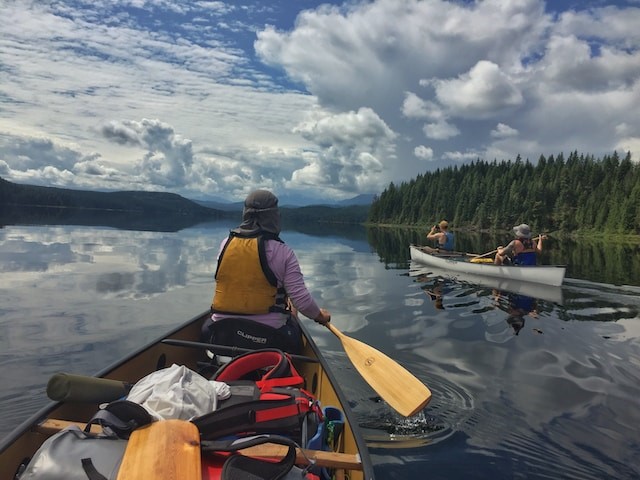
Canoeing Dressing in Different Seasons
What to Wear Canoeing in the Summer Season
For those new to canoeing, summer is often the chosen season. It provides ample flexibility in terms of attire, but preparedness is still key. Here's a glimpse into my summer canoeing wardrobe:
What to wear in Canoe?
Ensuring that all your clothing is quick-drying is paramount when you're in the canoe. Even on calm waters, canoes can tip unexpectedly, and sudden rain showers are not uncommon.
Moisture-Wicking T-Shirt:
Moisture-wicking T-shirts are designed to keep you comfortable by preventing the accumulation of sweat on your skin. The primary feature of a moisture-wicking T-shirt is its fabric, typically made from synthetic materials like polyester or blends that have moisture-wicking properties. These fabrics draw moisture (such as sweat) away from your skin and onto the surface of the fabric, where it can evaporate quickly. This process keeps you dry and helps regulate your body temperature. Moisture-wicking fabrics are often highly breathable, allowing air to circulate and cool your body. These T-shirts are usually lightweight, which is ideal for physical activities like paddling. When choosing a moisture-wicking T-shirt for canoeing, consider factors like fit, sleeve length, and neckline style to ensure it suits your preferences and provides the comfort and performance you need during your canoeing trips.
Quick-Drying Shorts:
Quick-drying shorts are a practical and comfortable choice of clothing for canoeing, especially in warm weather. Quick-drying shorts are typically made from synthetic materials like nylon or polyester. These fabrics have a high moisture-wicking capacity, which means they can efficiently move sweat and moisture away from your skin to the surface of the fabric, where it can evaporate quickly. The quick-drying nature of these shorts helps keep you comfortable during your canoe trip by preventing the build-up of moisture, which can lead to chafing and discomfort. These shorts are typically lightweight, which is important when you're actively paddling in a canoe. They won't weigh you down or restrict your movements. Some quick-drying shorts also offer built-in sun protection with UPF (Ultraviolet Protection Factor) ratings to shield your legs from harmful UV rays.
Fleece Sweater:
A fleece sweater can provide an extra layer of warmth without adding much weight or bulk. When considering a fleece sweater for canoeing, look for one that is lightweight, breathable, and fits comfortably over your base layer. It should provide the right amount of insulation to keep you warm without causing overheating. Having a fleece sweater on hand can be a smart choice for ensuring comfort and warmth during your canoeing adventures, especially in cooler summer evenings or during fall excursions.
Wide-Brimmed Hat:
Protect your face from the sun with a wide-brimmed hat. It also keeps your head cool.
Rain Jacket:
A fleece sweater can provide an extra layer of warmth without adding much weight or bulk. Due to its waterproof properties, can protect you from the sudden rain shower during canoeing. Its lightweight, breathable, sealed seams, adjustable cuffs and hems with hooded and zippered pocket is a great pick the canoe trippers want to have it in its gear.
UV-Protective Sunglasses:
Wear sunglasses with UV protection to shield your eyes from the sun's rays and glare off the water.
Water Shoes or Sandals:
Use water shoes or sandals with secure straps for excellent grip and quick drainage. For more details about footwear for canoeing is provided later in this blog. Please go to section Canoeing and Footwear.
Sunscreen:
Apply sunscreen to exposed skin to prevent sunburn.
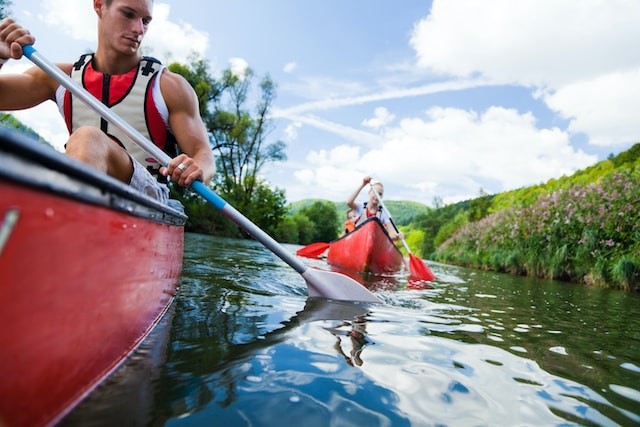
Choose a water-resistant formula for lasting protection.
Convertible Pants (Optional):
Consider convertible pants that can be turned into shorts for added comfort and versatility.
Personal Flotation Device (PFD):
Always wear a properly fitted PFD for safety, even in warm weather. Wearing a life jacket in a canoe is not just a recommendation; it's an absolute must. Regardless of whether you're paddling on flatwater or enjoying a calm day on the lake, always, always, always wear a life jacket. Modern life jackets are designed for both safety and comfort, and they come in stylish options. Remember, it's not just about looking cool; it's about safety, and it could potentially save your life.
Rain Pants (Optional):
Indeed, not everyone includes rain pants in their canoe trip essentials, but I highly advise giving them serious consideration, particularly for extended journeys. While hiking pants tend to offer water resistance, they often fall short when it comes to providing complete waterproof protection. Carrying a pair of rain pants can prove invaluable in keeping you both warm and dry, particularly in the event of sustained heavy rain during your expedition
What to wear on a Hot summer day during canoeing?
A short and a light T-shirt might be a smart choice for men. In case of women, a swimwear might be your primary choice for a hot day of canoeing, packing a few extra pieces of clothing, such as a T-shirt and shorts, can provide practical benefits, including sun protection, comfort, versatility, and an added layer of safety.
What to wear on Campsite during Summer Season?
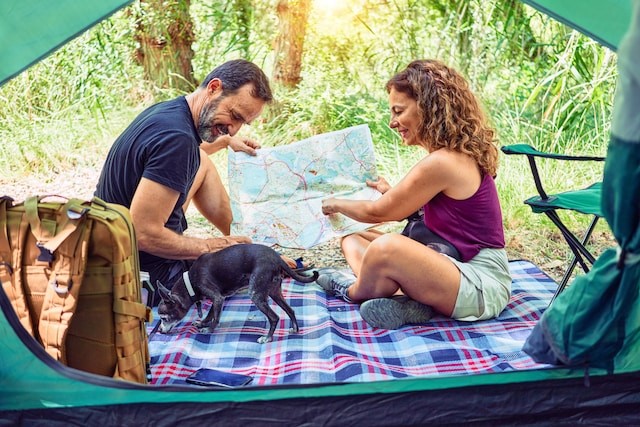
For Women:
Lightweight Maxi Dress:
A flowy, lightweight maxi dress is perfect for warm summer evenings. It's comfortable, easy to put on, and allows for plenty of airflow. Choose a design with adjustable straps for added convenience. However, please remember that if you plan to spend time outside your tent, mosquitoes could become a concern if you do not use mosquito repellent. You have two options for protection: you can either use mosquito repellent or wear a lightweight cardigan or kimono to cover your arms.
Not only will this provide warmth on cooler evenings and nights around the campfire, but it will also shield you from bug bites and mosquito attacks.
Athletic Shorts and Tank Top:
Opt for moisture-wicking athletic shorts and a breathable tank top. This combo is ideal for staying cool and comfortable after a day of outdoor activities.
Convertible Hiking Pants:
Convertible hiking pants are versatile. You can zip off the lower portion to transform them into shorts when the weather warms up. They are great for practicality and comfort.
Cotton Romper:
A cotton romper is another comfortable choice. It's easy to slip into and provides a relaxed, one-piece outfit that's perfect for night inside your tent. Additionally, even if the campsite environment isn't chilly and bugs aren't a concern, you can still wear it while you enjoy campsite activities.
Fleece pants are an excellent addition to your camping and canoeing wardrobe, particularly for cooler evenings or chilly mornings at the campsite. Fleece fabric is incredibly comfortable and soft against the skin. They are versatile and can be used for various outdoor activities beyond canoeing, such as hiking, backpacking, or simply lounging at the campsite.
For Men:
Cargo Shorts and T-shirt: Cargo shorts offer ample pocket space for carrying essentials, and a classic T-shirt is always comfortable. Look for moisture-wicking materials to stay dry.
Swim Trunks: If you're near water, swim trunks can double as comfortable shorts. Many swim trunks are designed to dry quickly and are perfect for a relaxed evening at the campsite.
Lightweight Hiking Pants: Lightweight hiking pants are practical and can be rolled up to create comfortable capri-style pants. They're great for adjusting to changing temperatures.
Casual Button-Up Shirt: A casual, short-sleeve button-up shirt can add a touch of style while still providing comfort. Choose breathable materials like cotton or linen.
Remember to bring along a light jacket or hoodie for cooler evenings, and don't forget to consider the specific weather conditions at your campsite.
Canoeing and Footwear
Selecting the right footwear for a canoeing and camping adventure is akin to choosing the perfect companion for a journey into the great outdoors. It's a decision that can significantly impact your comfort, safety, and overall enjoyment. When you're paddling down serene waterways or exploring the campsite's rugged terrain, your feet are your trusty guides. Water shoes, with their quick-drying properties and toe protection, excel in the aquatic realm, ensuring you're prepared for wet landings and rocky riverbeds. Meanwhile, a sturdy pair of hiking boots offers stability and support for those off-canoe excursions, like hiking to scenic viewpoints or setting up camp. And for casual campsite relaxation, lightweight sandals are the go-to choice, allowing your feet to breathe while unwinding by the fire. The right footwear can transform your canoeing and camping experience, ensuring each step is secure and comfortable, no matter where your adventure takes you.
Water shoes:
When embarking on a canoeing adventure, opting for water shoes is often the wisest decision. A water shoe is a type of footwear designed for activities in which the feet are expected to get wet, such as kayaking and canoeing. These shoes offer a comfortable, snug fit, ensuring that your feet stay protected from sharp rocks and debris while in the canoe. Moreover, their quick-drying properties mean you can effortlessly transition from water to land without discomfort.
These shoes are typically constructed from mesh materials and feature a sturdy sole designed to protect the feet from cuts and abrasions while walking in wet and rocky environments. Some models come with toe protection, which helps shield your toes from rocks or debris in the water.
Hiking Sandals:
Hiking sandals are lightweight, breathable, and have straps that provide a secure fit. Some models have closed toes for added protection. hese sandals offer comfort and versatility at the campsite and during short hikes. They allow your feet to breathe while still providing some protection.
Best Usage:
Great for campsite activities, short hikes, and for keeping feet cool in hot weather during canoe trips.
Wetsuit Boots:
There are chances you are canoeing in summer but the water you are canoeing in is cold. In that case wetsuit boots are the perfect choice. Besides, if you're an enthusiast in watersports, considering a pair of wetsuit booties is a smart move. Wetsuit boots serve a dual purpose: they shield your feet from the elements and enhance performance, regardless of your chosen watersport. They excel in activities like dinghy sailing, paddling, and kayaking, and canoeing offering comfort in cold water conditions while preventing cuts and scrapes. Notably, their exceptional grip is a compelling reason to invest in quality neoprene boots for watersports that involve trapezing and require a secure connection with the boat's surface.
Neoprene Socks with Water Shoes for Canoeing
Neoprene socks paired with water shoes form a dynamic combination that offers several advantages for canoeing enthusiasts. Neoprene socks are made from the same material as wetsuits, offering excellent insulation and protection. Water shoes are designed for wet environments and come with a rubber sole for traction and comfort. Together, they provide a flexible and comfortable barrier for your feet, ensuring a snug fit.
Neoprene socks with water shoes are best suited for canoeing trips during the early spring or late fall when water temperatures are cooler. They provide the necessary insulation to keep your feet warm. Avoid using this combination in extremely hot weather, as it may cause your feet to overheat.
Wool Socks
Wool socks, though not the first choice for canoeing trips, can serve a specific purpose in certain situations. Wool socks are typically made from natural or synthetic wool fibers, which provide insulation and warmth. Wool is renowned for its exceptional insulation properties, even when wet. Wool socks can provide warmth in cooler weather, making them suitable for early spring or late fall canoeing trips. Wool has natural moisture-wicking properties, which can help keep your feet dry and comfortable. Even if your feet sweat or get wet, wool socks can still provide insulation.
Wool socks are best used when canoeing in cooler weather conditions or when there's a higher risk of getting wet, such as during early spring or late fall trips. Avoid using thick wool socks in hot or humid weather, as they can make your feet feel overly warm and sweaty. Consider the weather and water conditions when deciding whether to incorporate wool socks into your canoeing gear.
Campsite footwear Essentials
At the campsite, lightweight and breathable hiking sandals become a versatile choice. They provide comfort during campsite activities and allow your feet to breathe, keeping you cool on warm summer nights. With the right footwear, you can navigate the waterways with confidence and relax at the campsite in comfort, making the most of your canoeing experience.
Headwear Essentials:
Choosing the Right Gear for Your Adventures As you prepare for your upcoming canoeing adventure, there's more to think about than just your paddle and life jacket. Your choice of headwear plays a vital role in keeping you comfortable, safe, and prepared for the elements. In this section we will talk about different types of headgear that are essential for canoeing and campsite activities. From sun protection to staying dry in the rain, we've got you covered with practical recommendations and guidelines for each headwear option.
Wide-Brimmed Sun Hat: Wide-brimmed sun hats are your best defense against the scorching sun. They feature a broad brim that shades your face, neck, and ears. Perfect for sunny days on the water to prevent sunburn and keep you cool.
Boonie Hat: Boonie hats are known for their all-around sun protection with a wide brim and adjustable chin cord for a secure fit. Best Use: Ideal for canoeing and hiking in rugged terrain, ensuring sun and rain protection.
Waterproof Hat: These hats are designed with waterproof materials to keep you dry during unexpected rain showers. Essential for staying dry and comfortable in rainy conditions while canoeing or camping.
Neoprene Beanie: Neoprene beanies provide warmth and insulation, making them perfect for cooler canoeing trips. Wear in early spring or late fall when water temperatures are colder.
Lightweight Cap: Lightweight caps are breathable and wick moisture, offering comfort in hot weather. Ideal for staying cool and protected from the sun on sweltering summer canoeing days.
Mosquito Head Net: A head net protects your face and neck from pesky insects, like mosquitoes and gnats. Essential for campsite activities in buggy environments, keeping insects at bay.
Bandana or Buff: Versatile and multifunctional, these can be worn as headbands, neck gaiters, or balaclavas, providing sun and wind protection. Use as needed to shield from sun, wind, or dust during canoeing or campsite activities.
Canoeing in Cooler Seasons: What to Wear for Early Spring and Late Autumn
In management, there is a famous quote “if you fail to plan, you plan to fail”. Just like every other aspect of the camping, planning the trip is highly important. Canoeing in the early spring and late autumn can be a serene and picturesque experience, surrounded by the changing colors of nature. However, these seasons bring cooler temperatures and variable weather, making it essential to dress appropriately for comfort and safety. Here's a detailed guide on what to wear for canoeing during these transitional seasons. Start with a moisture-wicking, long-sleeve shirt on top. Opt for materials like merino wool or synthetic fabrics to keep sweat away from your skin.
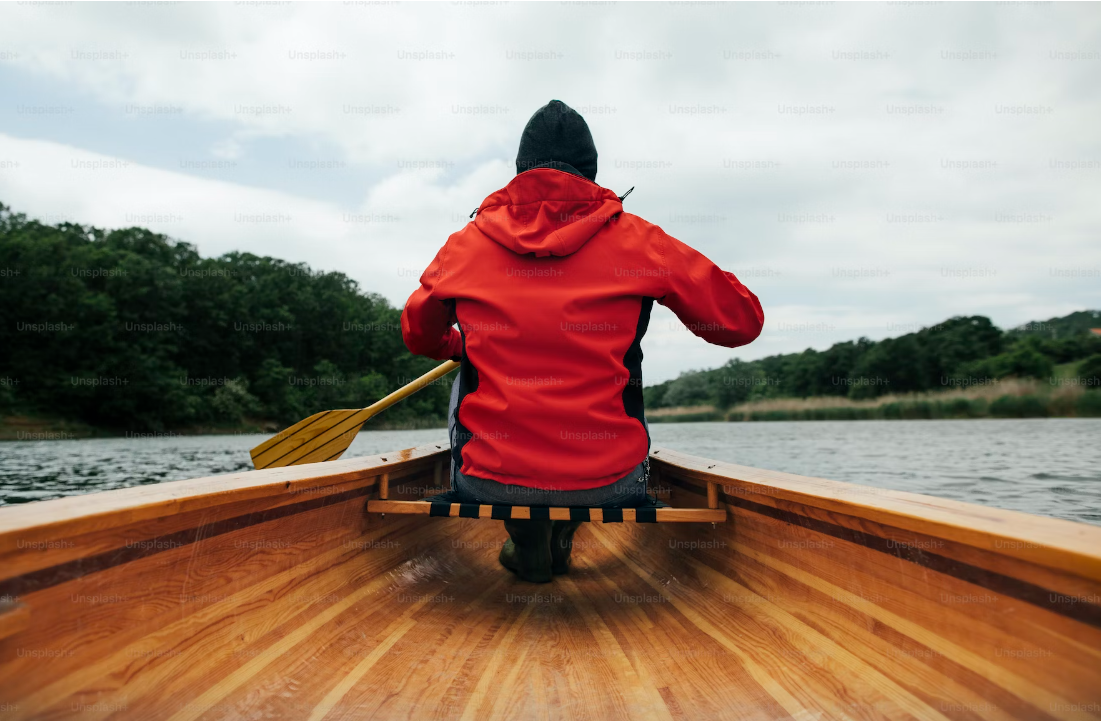
Layer up with an insulating jacket to trap your body heat. Lightweight fleece or down jackets work well to provide warmth without bulk. Keep your lower body dry with waterproof pants. Look for breathable options to prevent overheating during physical activity. Don't overlook the importance of a warm hat to retain heat. A beanie or thermal headwear is perfect for the job.
What not to bring
Cotton Attire:
The phrase "Cotton kills" is a well-known cautionary saying in the outdoor community, and it holds a crucial lesson for anyone venturing into the wilderness. Cotton clothing can pose serious risks when exposed to moisture:
Slow Drying:
Cotton has a notorious reputation for retaining moisture. When it gets wet, whether from rain or sweat, it takes a considerable amount of time to dry out. This slow drying process can leave you uncomfortably damp for extended periods.
Hypothermia Risk:
Prolonged exposure to wet cotton can lead to a drop in body temperature, increasing the risk of hypothermia, especially in colder conditions. Hypothermia is a potentially life-threatening condition characterized by a dangerous decrease in core body temperature.
Poor Moisture Wicking:
Cotton is not an ideal choice for a base layer because it lacks moisture-wicking properties. Instead of drawing perspiration away from your skin, cotton tends to absorb and hold onto moisture, leaving you feeling damp and chilled.
Blends to Avoid:
It's essential to be aware of fabric blends that include cotton, such as cotton-polyester blends, as they can exhibit similar moisture-related issues. Additionally, some synthetic materials like rayon, TENCEL, and viscose may not perform well in moisture management.
Jewelry:
When preparing for a canoeing adventure, it's wise to leave behind bracelets, necklaces, and rings. These accessories can pose certain risks while on the water:
Snagging Hazards:
Bracelets, necklaces, and rings may inadvertently catch on something in the canoe or surrounding environment. This can lead to unexpected entanglements, causing inconvenience and potentially disrupting your canoeing experience.
Loss Risk:
There's also the risk of losing these valuable items. If not securely fastened, they may slip off your wrist, neck, or fingers and end up sinking to the bottom of the water, making retrieval challenging.
Consider Water-Resistant Alternatives:
If you feel the need to wear a timepiece or a fitness tracker during your canoe trip, opt for a water-resistant model with a synthetic band. These specialized accessories are designed to withstand splashes from paddles or even a brief immersion in water in case of a capsize. They offer the functionality you desire without compromising safety.
